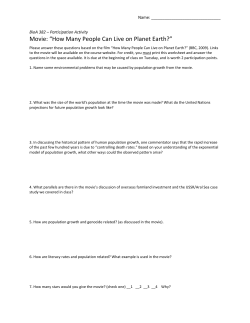
Ch 6 PPT - Elasticity
Total Revenue Test Uses elasticity to show how changes in price will affect total revenue (TR). (TR = Price x Quantity) Elastic Demand• Price increase causes TR to decrease • Price decrease causes TR to increase Inelastic Demand• Price increase causes TR to increase • Price decrease causes TR to decrease Unit Elastic• Price changes and TR remains unchanged Ex: If demand for milk is INelastic, what will happen to expenditures on milk if price increases? Is the range between A and B, elastic, inelastic, or unit elastic? 10 x 100 =$1000 Total Revenue 5 x 225 =$1125 Total Revenue A 50% B 125% Price decreased and TR increased, so… Demand is ELASTIC You Should Now Get This • Elastic and Inelastic Demand Baby – Winner 2013 Econ video contest 3 Total Revenue Test Total Revenue Test } inelastic } unit elastic }elastic Elasticity Practice 8 • Graph the following chart • Calculate the Ed using the top set of numbers and prices rising Answers -Graph • This is what your graph should look like Answers - Ed • Ed = % change in quantity demanded of product X % change in price of product X % Change in quantity = nqd – iqd initial quantity demanded % Change in price = New Price – Initial Price Initial price Ed = (90 – 100) ÷ 100 ($2 - $1.00) ÷ $1.00 • Ed = -.10 = -.1 1 Drop the negative: Ed is < 1 therefore the demand for is INelastic • Calculate the TR and determine if Total Revenue increased or decreased with a price increase • What is gain or loss on price move? Answers • $3 * 70 = $210 • $2 * 90 = $180 • Total Revenue increased $30 What Happens If --• Graph the following chart • Calculate the Ed using the bottom two numbers and prices rising Answers - Ed • Ed = % change in quantity demanded of product X % change in price of product X % Change in quantity = nqd – iqd initial quantity demanded % Change in price = New Price – Initial Price Initial price Ed = (40 – 70) ÷ 70 ($4 - $3.00) ÷ $3.00 • Ed = -.4285 .3333 or 42.85% = 1.28 or 33.33% Drop the negative: Ed is > 1 therefore the demand for is elastic Ed & TR Test “quiz” Practice Problem • See handout Consumer and Producer Surplus • Consumer Surplus – Difference between maximum price willing to pay and the actual price producers charge – Think of it as a “willing to pay” curve 18 Marginal Benefit & Surplusses • Marginal Benefit – What you gain when you get one more unit – Measured by what you are willing to give up – Everyday life we say “getting value for our money” – There is a difference between value and price Value vs. Price • Value is what we get • Price is what we pay • Everyday idea of value is marginal benefit OR • The measure of the maximum price what consumers are willing to pay for another unit of a good or service Pizza Sales Per Slice Consumer Surplus P Consumer surplus from 10th slice of pizza 2 Willing to pay 1.5 Market Price $1 .5 Amount Paid D 10 20 30 40 Voluntary Exchange In the free-market, buyers and sellers voluntarily come together to seek mutual benefits. 22 Voluntary Exchange In the free-market, buyers and sellers voluntarily come together to seek mutual benefits. 23 Voluntary Exchange In the free-market, buyers and sellers voluntarily come together to seek mutual benefits. 24 Voluntary Exchange In the free-market, buyers and sellers voluntarily come together to seek mutual benefits. 25 Example of Voluntary Exchange Ex: You want to buy a truck so you go to the local dealership. You are willing to spend up to $20,000 for a new 4x4. The seller is willing to sell this truck for no less than $15,000. After some negotiation you buy the truck for $18,000. Analysis: Buyer’ Maximum- $20,000 Sellers Minimum- $15,000 Price- $18,000 Consumer’s Surplus-$2,000 Producer’s Surplus- $3,000 26 Voluntary Exchange Terms Consumer Surplus is the difference between what you are willing to pay and what you actually pay. CS = Buyer’s Maximum – Price Producer’s Surplus is the difference between the price the seller received and how much they were willing to sell it for. PS = Price – Seller’s Minimum 27 Consumer and Producer’s Surplus P Calculate the : 1. Consumer Surplus 2. Producer Surplus 3. Total Surplus $10 S 8 6 $5 4 CS PS 2 1 D 2 4 6 8 10 Q 30 Calculating Consumer Surplus In Dollars Max Willing to pay Actual price (E) Calculate CS $9 $5 9–5= $4 $8 $5 8–5= $3 $7 $5 7–5= $2 $6 $5 6–5= $1 $5 $5 5–5= $0 Sum = CS = $10 31 Calculating Producer Surplus In Dollars Min Price charged Actual price (E) Calculate PS $2 $5 5–2= $3 $3 $5 5-3= $2 $4 $5 5-4= $1 $5 $5 5–5 = $0 Sum = PS = $6 32 Surpluses • Could be calculated in Quantity 33 Summary Consumption Inefficiency Production Inefficiency Practice Problem Name of Consumer Matt Don Sarah George Ann Price willing to pay $20 $15 $8 $12 $7 Q. If dinner sells for $10, what is the value of Dons’ consumer surplus? Practice Problem Name of Consumer Matt Don Sarah George Ann Price willing to pay $20 $15 $8 $12 $7 Q. If dinner sells for $10, what is the value of Dons’ consumer surplus? A. Willing to pay is $15. Market price is $10. Willing to pay ($15) – Actual Price ($10) = $5 Practice Problem Name of Consumer Matt Don Sarah George Ann Price willing to pay $20 $15 $8 $12 $7 Q. If dinner sells for $11, what is the TOTAL value of consumer surplus? Practice Problem Name of Consumer Matt Don Sarah George Ann Price willing to pay $20 $15 $8 $12 $7 Q. If dinner sells for $11, what is the TOTAL value of consumer surplus? A. 20 – 11 = 9, 15 – 11 = 4, 12 – 11 = 1 9 + 4 + 1 = $14 consumer surplus • For a given linier demand curve, the value of consumer surplus does what as market price increases? • For a given linier demand curve, the value of consumer surplus does what as market price increases? • Decreases as market price increases (1) Price (2) QA (3) (4) QB (5) (6) QC (7) $10 9 8 7 6 100 111 125 143 167 $_____ _____ _____ _____ _____ 100 130 170 220 280 $_____ _____ _____ _____ _____ 100 110 120 130 140 $_____ _____ _____ _____ _____ 5 200 _____ 350 _____ 150 _____ 15. A marketing firm has done a study of market demand for DVDs of three different movies. Calculate the total revenue for each movie in columns 3, 5, and 7. Without calculating the price elasticity of demand, indicate whether demand for each movie is elastic, inelastic or unit-elastic. For which movie would a reduction in price produce the greatest increase in revenue? 41 (1) Price (2) QA (3) (4) QB (5) (6) QC (7) $10 100 $1000 100 $1000 100 $1000 9 111 999 130 1170 110 990 8 125 1000 170 1360 120 960 7 143 1001 220 1540 130 910 6 167 1002 280 1680 140 840 5 200 1000 350 1750 150 750 Without calculating the price elasticity of demand, indicate whether demand for each movie is elastic, inelastic or unit-elastic. For which movie would a reduction in price produce the greatest increase in revenue? Applying the total revenue test, we see that total revenues remain approximately constant for movie A, meaning that demand is unit-elastic. Total revenues for movie B are increasing as price decreases, meaning that demand for movie B is elastic. Total revenues for movie C are decreasing as price decreases, meaning the demand for movie C is inelastic. [text: E pp. 77-80; MA pp. 77-80; MI pp. 77-80] 42
© Copyright 2025
















